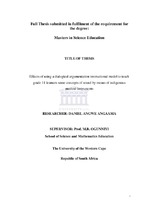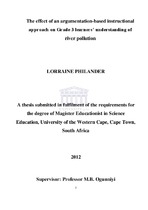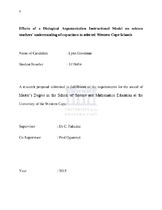| dc.contributor.advisor | Ogunniyi, Meshach B. | |
| dc.contributor.author | Angaama, Daniel Angwe | |
| dc.date.accessioned | 2014-05-26T12:43:58Z | |
| dc.date.available | 2014-05-26T12:43:58Z | |
| dc.date.issued | 2012 | |
| dc.identifier.uri | http://hdl.handle.net/11394/3227 | |
| dc.description | Magister Educationis - MEd | en_US |
| dc.description.abstract | Two grade 11 classes of two high schools in Cape Town were taught some concepts
of sound by means of indigenous musical instruments. The purpose was to find out
the relative effects (or none) of two instructional strategies. Toulmin (1958)’s
Argumentation Pattern, Ogunniyi (1997)’s Contiguity Argumentation Theory and
Reiner et al. (2000)’s Substance Schema formed the theoretical framework.
A pre-post-test quasi-experimental design was employed and data collated using
questionnaires, a sound conceptual test, argumentation worksheets, and classroom
observation schedules. One teacher taught the experimental group using dialogical
argumentation while another teacher taught the comparative group using lecturedemonstration method, coupled with the use of ICTs for duration of four weeks.
Data were analysed using a mixed (quantitative and qualitative) methods approach.
The findings revealed that many the learners held some scientifically valid conceptions of sound prior to formal instruction. However, the learners also held many scientifically invalid conceptions in relation to the speed of sound in air, sound propagation, and sound produced by stringed instruments. The alternative conceptions of learners in the C group remained largely unchanged after instruction, while those of the E group changed appreciably, but not completely. The E group learners changed the alternative conceptions that were worked into structured argumentation activities better than those which were not. Also, the learners in both groups seemed to hold indigenous beliefs in relation to sound which did not seem to change after instruction. Most learners had a positive attitude towards the use of indigenous knowledge in the science class. No significant difference was found between male and female learners with respect to conceptual understanding of sound, indigenous beliefs, and interest in the integration of science and indigenous knowledge. | en_US |
| dc.language.iso | en | en_US |
| dc.publisher | UWC | en_US |
| dc.subject | Toulmin’s argumentation pattern | en_US |
| dc.subject | Contiguity argumentation theory | en_US |
| dc.subject | Reiner et al.’s substance schema | en_US |
| dc.subject | Dialogical argumentation | en_US |
| dc.subject | Dialogical argumentation instructional model | en_US |
| dc.subject | Alternative conceptions | en_US |
| dc.subject | Conceptual understanding | en_US |
| dc.subject | Indigenous musical instruments | en_US |
| dc.subject | Indigenous beliefs | en_US |
| dc.subject | Sound propagation | en_US |
| dc.title | Effects of using a dialogical argumentation instructional model to teach grade 11 learners some concepts of sound by means of indigenous musical instruments | en_US |
| dc.type | Thesis | en_US |




